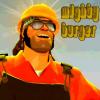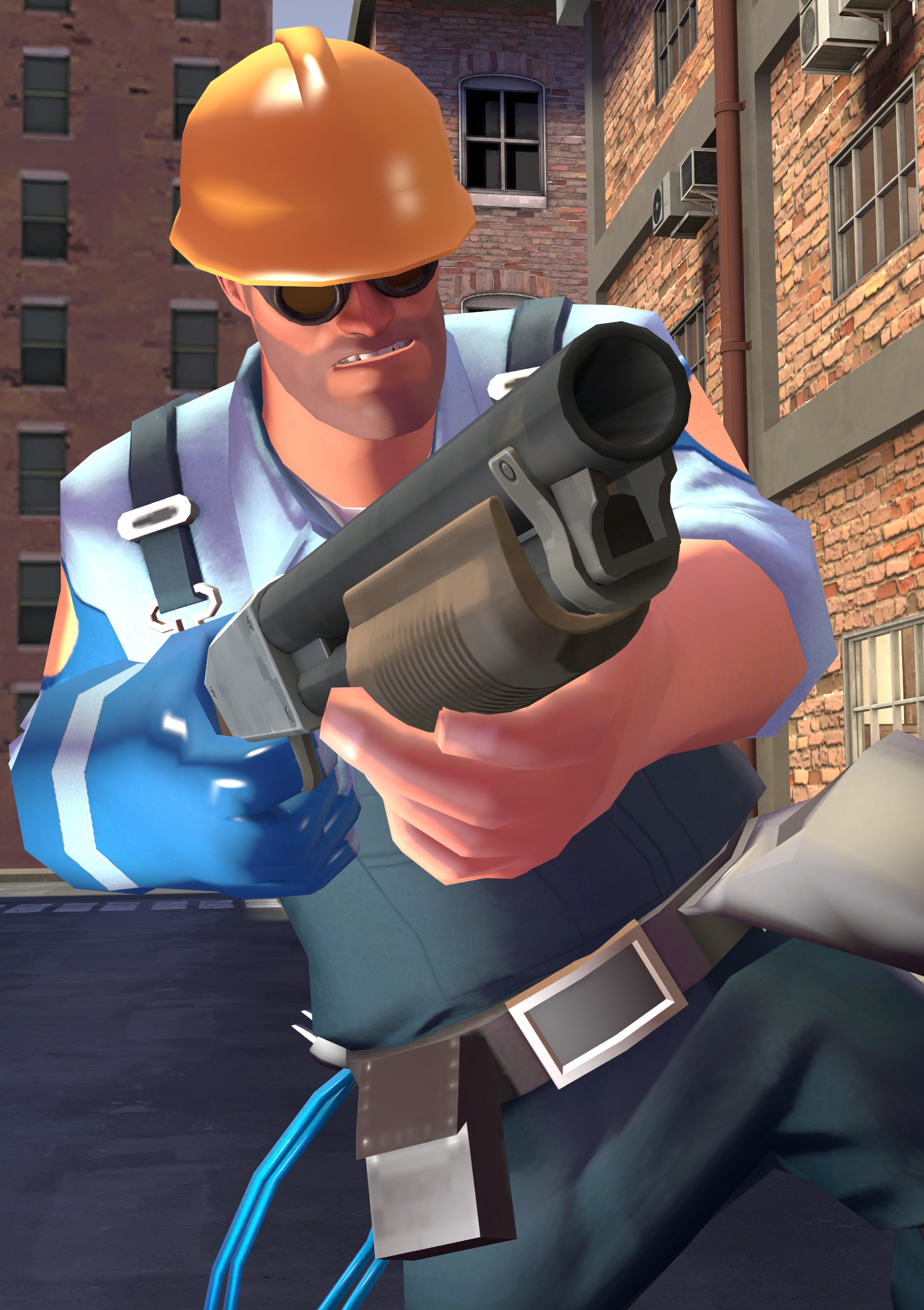“If it isn't nobuilt, it's fair game.” -Gamemaster
"Once you get the basics down, engineering is more an art than a group of determined skills set in stone" -Mighty Burger
"Engineers are less focussed on one area, but the scope is much much wider." -Foxy
“Do most people just not get what is important about playing engie, and do it wrong? Yes.” -Sigafoo
Introduction
Whether it is out of curiosity, genuine interest for the class, or just to let another one take the Sniper slot to get that damn lobby started once and for all, you’ve decided to play Engineer. It may be not the sexiest class, or the most powerful, but it is still vital to the success of any team in the long run.
You will ask yourself common practical questions such as “Where do I build”, “What loadout should I use?” or “How do I stay alive?”.
This guide is not here to give you those concrete answers to these, but rather provide some insight on the mindset that you should have while playing with Dell.
As much as I would like to, telling you about the “best practices” for playing competitive engineer would be a dirty lie. With such variables as the player, his playstyle, his loadout, his own team, the team he’s up against and the map features, you can’t realistically have one best way to deal with every scenario, let alone predicting all the possibilities to begin with. This contributes to making the Engineer’s gameplay a very dynamic one, with no two games being quite the same.
That being said, welcome, young hardhat!
Engineer mindset
The Engineer’s role is one of support; his priorities are to defend his teammates as well as to provide them with optimal fighting conditions. Aggressive deathmatch, providing covering fire, area denial, guarding objectives, pushing carts and capturing points are only means to achieve these ends. They are not goals per se. This makes the Engineer a rather versatile class, with many ways of accomplishing its tasks properly. But regardless of the playstyle that you chose to adopt, adaptability (gamesense + know-how) and consistency will always be the most important skills to impose your presence on the field. Common mistakes include completely sacrificing support for aggression (“slow Scout”), “blueprint playing” (only doing the same thing, regardless of whether it fits the situation or not, just because you’ve seen X do it successfully) and being impatient. That is also a reason why it can be tricky to try and judge how well you are doing by looking at damage and kills. If you are on the flank for instance, preventing the Scout from contesting your position and calling out the Spy or making him back off will not always result in kills and massive damage, but you are drastically reducing their effectiveness and hence are doing your job. If you provide a safe haven for your team, and that no one in the enemy team will be stupid enough to penetrate it before getting an uber, you haven’t killed anyone, but you’ve done your job at defending your team and delaying the enemy.
Awareness
A deaf Engie is a dead Engie . I cannot stress just how much auditory awareness is necessary to be effective. Since you won’t be on the frontline many times, you need to listen to the comms and game audio cues to compensate for what you can’t see, to be aware of what is going on and to keep up with what your team does and needs. You will better anticipate situations and increase your survivability.
Conversely, not being constantly on the frontline enhances your vigilance, allowing you to pay more attention to threats (flankers, snipers and spies). But a mute Engie is the same thing as a blind one. Notify your teammates so that they can react accordingly (make sure you follow some communication rules while doing so).
That is why you must use mumble whenever you can, just don’t clutter.
Here are some important sounds that you should listen for and related notification (if applies):
- Uber : “they called [location]” (only if no one else says it)
- Cloak sounds! The gunfire in the combo prevents them from hearing them, but you’ll be hanging in less action-packed areas, where the whoosh stands out much more : “Spy uncloaked [location]”. And if you are really a boss with good headphones, you can even track their footsteps in calmer areas when they go invisible (useful against those ringa-dingers trying to fool you).
- Sentry alert sound. If your sentry detects something and rotates towards an unusual spot, you’ve got a flanker that needs dealing with: “Sentry picked up something [location]” or “Someone flanking [location]” (say the class if you see/hear it).
- Hurt cries. Sentries are great detectors, but you won’t always be seeing who they are shooting: “[class][location]”
A note on maps : This class is the most dependent on map knowledge ! Get familiar with locations offline or on pubs first before simply jumping at the deep end of the pool. You can also skim through a couple of broadcasted matches to get an idea of some spots that you can use to begin with before setting out to develop new ones. Don't mindlessly copy positioning of others if you don't understand their underlying logic. This leads to what I call "blueprint playing", or what Gamemaster calls "monkey-see-monkey-do" mentality. I'll even go ahead and say that you'll learn more from other Engineers' failures than their successes, as this will teach you the right reflexes to look for when developing your own playstyle and builds.
A note on Spies : spychecking is a collective responsibility, but not all classes do it the same way. The fact that all Spies will do anything to avoid the Pyro until they strike makes the latter a last line of defence against them rather than an early warning. In fact, if the Pyro fails to intercept the attack, it’s because the Scout, Engineer and Soldier failed to call him out in the first place (or outright shut him down) when he was still on his way. As an Engineer, you are probably the best spotter when not busy with defence duty, and your shotgun will easily dispatch a Spy.
Tools for the job.(that are allowed)
Most classes can stick with the same loadout throughout an entire match and still be okay. That is not the case with the Engineer. Choosing an adapted loadout and taking full advantage of it is already half the battle. But switching between loadouts cannot be done lightly, so choose wisely. And to choose wisely, you need to ask “What needs to be done and when?” and “In what way can X item help me do it?”. Even without his sentry, an Engineer can deliver a nasty sting. But you’re still very squishy, and unlike the Scout, you can’t run easily run away if things turn sour for you.
Weapons
Melee weapons (starting with these because they’ll define your play style more than anything else)
Wrench/Southern Hospitality/Jag
Despite the debates, I still think that their use boils down to personal preference. A couple of valid points exist to justify the use of one over the others.
- The Wrench is well rounded and is good to teach you weapon discipline: you shouldn’t melee more just because you have the SH, and you shouldn’t have sloppy timing or move stuff recklessly just because you have the Jag (who’s bonus is negligible anyway) unless you’re a diehard fan of the other two, I’ll always recommend starting out with this one.
- The Southern Hospitality’s extra bleed damage is appealing when your loadout isn’t particularly damaging to begin with (RR/Wrangler), and neutralizing Spies becomes an easier task when you don’t have the time to whip up your boomstick.
- The Jag’s bonus only benefits you if you’re actively hitting your buildings, which makes you a sitting duck in many cases, and not just for Spies. Use it if you plan on redeploying your buildings often (ex: running a normal sentry on payload offence or even 5cp lol), or to maybe build a throwaway sentry in a pinch as a last resort to cover your retreat. I personally find it the most sub optimal wrench of the three for most situations.
Eureka Effect
Oldschool Engie with a twist! You can’t move your buildings, so make sure to have your positioning well figured out beforehand. If you’re not far from spawn or have a teleporter up, your nests can be hard to neutralize without having to overrun it. If you get cut off, the teleport feature can allow you to escape instead of waiting 15 seconds (you’re still very vulnerable while taunting so find a safe spot first). Use it when your nest is too out of the way to be relevant or salvageable after the objective it was supposed to guard has been captured (ex: Badwater cliff), or when a spawn change will make it highly unsafe (ex: Upward 2nd, Badwater 2nd), or more generally if you plan on using few yet strong defensive positions that you intend to hold onto for as long as it’s safe before quickly relocating.
In a nutshell, you gain extra flexibility while relocating (strategic flexibility) in exchange of flexibility during holds (tactical flexibility). This makes the EE a somewhat niche wrench, but still fun to use.
Gunslinger
With increased health and the fast-building mini-sentries, it’s the battle Engineer’s weapon of choice. Use it when presence on the flank as a skirmisher is more important than durable staying power close to the front line, and when staying on the move is more important. It’s useful to stabilize situations when you have neither the time nor the support to use a regular sentry, and when helping your team regroup in high pressure situations is the top priority.
Primary weapons
Shotgun.
The old boomstick is a solid and reliable weapon. It has the best standard damage output and is adapted to any situation. Recommended if you plan on going for a more aggressive control of the flanks, or to defend yourself when using more passive sentry position at the rear (ex: Upward 3rd, all the way at the back), where team support is more scarce and your sentry is less immediately pressured. But overall, you can't really go wrong with it.
Frontier Justice.
Trading sustained fire for a potential increase in burst damage, the FJ and its revenge crits can make you a force to be reckoned with. “Can” because without them it’s just a shittier shotgun with a halved clip. A bit like a Soldier’s banner, the FJ is only really good if you are already winning, or if someone on the other team is feeding your sentry. This should never be your go-to option at the start of a round; but if you die and your sentry stays up with enough kills/assist for AT LEAST 4-5 crits, it’s not unreasonable to equip it in the hopes of making a comeback (these are revenge crits after all!).
Upon your sentry’s destruction, you receive 1 revenge crit per assist and 2 per kill. While typically paired with the Gunslinger, it is viable to use with other wrenches, since you won’t need to fight as much until your sentry gets wrecked and you need to relocate. With crits and good aim, harassing you may be a much less appealing option. A moot point to this reasoning is that you can only benefit from your crits if your sentry is destroyed in the first place. This means that without crits to begin with, you won’t be able to defend yourself as well; and sacrificing your area control for crits is a terrible calculus.
Despite the revenge crit mechanic, it’s a fairly defensive weapon at heart.
Widowmaker
Costing 30 metal units per shot and granting back metal equal to the damage dealt, this weapon is only as reliable as your aim, pure and simple. Missing at the wrong time could be your undoing: you lose both your primary AND your ability to build. It’s safer to use it on maps where metal is easily found in case of an emergency, and by having the Pistol as a backup. Shooting enemy buildings also gives you metal. The aggressive nature of this weapon makes it unsuitable for Wrench loadouts, where your metal will be used to maintain your nest and your primary to pepper around to spycheck or harass, two things that the widowmaker is worthless at. Also, do note that as an offensive Engineer, you’ll be hanging out more towards the flank, and hence encounter mostly light and agile classes (who can easily bob and weave and make you miss), and occasionally the Soldier (who will rip you to shreds in most 1v1 scenarios). Personally, I find the Widowmaker a good pub stomper, but a risky gamble that doesn’t provide a lot of flexibility in comp.
Given the opportunity, a Widowmaker Engineer can make a decent last resort Kritzkrieg target if the pockets die (I insist on that “last resort” part).
Rescue Ranger
With its projectile bolts, average damage output, reduced clip and less carried ammunition, this weapon is definitely not meant for frontal combat. However, it grants you the unique ability to repair your buildings from a distance for no cost in metal (+75 hitpoints per bolt less than the Melees’ +105) and to haul them from anywhere provided that you have a clear line of sight and have at least 130 metal units. You will be marked for death while hauling, making you very vulnerable when repositioning buildings. Useful when you want to make your buildings tank as much damage as possible without exposing yourself too much, to save your metal for other buildings, and to quickly switch position while minimizing hauling time.
It is recommended to use it to maintain aggressive sentry placements, as these are likely to be the target of constant spam, with little downtime to get near and repair. It’s also very strong when paired with the Wrangler, as the latter effectively triples your sentry’s health (and by extension your repairs’ effectiveness). Don’t get too cocky though, as a Spy sap can easily crash your party if you’re too far away to unsap in time. Also, being a projectile weapon, the further you are, the more you need to anticipate incoming damage to your buildings. There’s no problem equipping it with the Eureka Effect if you simply want to focus on tanking.
Finally, the hauling feature can allow you to quickly set up your sentry and maybe dispenser to areas where a classic setup would normally have taken too long to be practical. A perched sentry is unsappable, and the engineer can still repair it from safety.
Secondary weapons
Pistol
Spammable at will, and can deal significant damage with proper tracking. Use it to harass/finish off enemies at mid to long range, to stack damage with your sentry gun or as a last resort when you don’t have time to reload your primary.
Wrangler
A very popular secondary, but that doesn’t mean that it should be equipped all the time ofc, especially with the Gunslinger. The reasons to equip it include drastically increasing your sentry’s resilience and firepower (good to force and tank ubers so that your own medic doesn’t have to pop early if at all), providing reliable long range harassment and/or eventually shutting down sniper lanes. It comes in handy to quickly spycheck when defending with a normal sentry.
Do bear in mind that to do all these wonderful things, you need to have a sentry up in a relevant position to begin with. If not, it will be as good as equipping Gunboats with a Rocket Jumper. Also, don’t let your guard down when wrangling, especially if your position is very aggressive and wrangler-heavy. Your sentry can’t detect and/or protect you from unexpected flanking attacks, and smart enemies will find it much easier and faster to kill a defenseless 125hp class than to focus down a 648hp sentry.
Buildings
Your buildings, your team and you.
A very widespread misconception is to view the Engineer’s buildings as simple machines, which only serve as a crutch for the Engineer character’s lack of particular strength, and as a way to compensate a supposed lack of DM skill. From here stems the belief that deathmatch skill is the only thing that separates the okay engies from the great. This is mostly apparent in the phrase “a fat scout and a portable aimbot”.
But what makes the Engineer an Engineer are precisely his buildings!
And these are more than dumb machines: they are your way of controlling the flow of battle by giving your team an edge in mobility, map control and resources over the other one. A team that has its mobility restricted cannot choose where and when to fight, and this makes their behaviour more predictable.
From the days of QWTF, the class’s strength was always its ability to provide armour (health in tf2), ammunition, and safe havens to regroup/heal/restock or to protect critical objectives. The introduction of teleporters in TFC went further along this path, although it was only in the slower paced and conc-less TF2 that they showed their true potential. An Engineer may not be the big star of the show, but if he doesn’t do his job, the whole team will feel the impact : power classes run out of ammo, lighter classes aren’t healed properly, lots of walking for the Heavy (you monster!), lots of stress for the Medic and an overall precarious map control. Likewise, the team should also do its best to work with the Engineer in return (a lone engie is a dead engie) and not just play and hope that he will adapt in the blink of an eye every two seconds.
When talking about buildings, positioning is what will ultimately make or break your holds.
What makes a good position is one where the combined work of your team and your buildings’ can effectively delay the enemy team for a good amount of time. However, the more a spot gets used, the less effective it becomes. This is especially true for so-called “standard” holds : for each textbook hold, there is an equal and opposite textbook takedown strategy. Despite being solid spots in their own right, people have wised up to them so much that they can almost attack them with their eyes closed. There’s no harm in using them, just don’t use them constantly and fall into the pitfall of blueprint playing. I cannot stress enough just how important it is to vary your positions to keep your adversaries on their toes, to always have more than one trick up your sleeves. A less optimal but unexpected spot can stall unprepared team longer than an overused one. Surprise is not a crutch, but a strength like any other.
On a final note, no matter how important his buildings are, the Engineer's own life is ultimately much more important. If your stuff gets trashed, you can move and rebuild. If you get trashed, you're buildings are no longer repaired and will follow the same fate shortly after (see Foxy's notes below).
Building positioning and roles
The Sentry
A first question you should ask yourself is: Do I want to continually defend the objective more to help my team better engage the opponent? Or do I want to defend my team so that they can better focus on covering the objective when needed? Nothing illustrates this dilemma better than "barn nest or cliff nest?" decision on Barnblitz 1st.
Further questions include :
- What does it see? What does it not see?
- How often will I need to use the Wrangler ?
- What is covered with and without wrangler?
- Where can it be attacked from and by what? Will it be easy for them?
- Can my team deal with its vulnerabilities without over-committing?
- How close can the enemy medic get before popping his uber (further means less effective uber time for a takedown)?
- Is metal available nearby if my dispenser gets trashed? How much?
Dispenser
Too often overlooked in lower levels of play, it’s a vital building for the Engineer and/or his team; making it an important pick in matches (this is especially true in koth, so don't laugh at "dispenser down" calls). Just like the sentry, dispensers have their own spots, each one serving different purposes depending on the circumstances.
On defence, the dispenser is chiefly for the Engineer and his nest, to provide him with the metal and health that he so desperately needs to maintain all his buildings. He’s the backbone of the defence after all! This also turns his nest into a safe area where his team can regroup and stage counter-attacks under the sentry’s protection. The beacon-like nature of the dispenser also makes it more difficult for spies to harass the Engineer with impunity.
On offence, I like to place it a bit further behind the front lines, in a semi protected spot where retreating teammates won’t get harassed or sniped. Too far forward and you could end up giving the enemy team an easy multikill.
From personal experience, the Pyro will be the a very big benefiter of your dispenser in an offensive setting, followed by the Scout and Soldier. A good dispenser makes a happy Pyro, and favors a healthier flank control. (example: http://logs.tf/13600...561198023936106, scroll at the medic healing section and look for my name)
Teleporters
Their purpose is to reduce travel time and to generate traffic where it would have been impossible otherwise. However, there are two rules to follow for these:
- Safety first! Don’t place them too far forward where they will be easy to destroy and/or put your teammates in unnecessary danger. Also, don’t place them in spots with only one campable exit (also known as a firesack). An example of this would be in the Steel C/D corridor, on the health pack.
- Influencing is not dictating! A good spot will allow smoother tactical transitions between pushing and holding by being in a well connected area. Try not to restrict you and your team’s tactical options by using one-way spots (with the exception of deliberate team strats, but that’s another thing since its a common decision)
Knowing the field
Deployment is a art
Just like Demomen and Soldier, Engineers also have their rollouts. But instead of balancing speed, health and aggression, the Engineer's deployments are more focused on how to best use the available time, metal and map features to position himself and his gear as quickly and efficiently as possible. All this while still taking into account what was previously said about buildings and loadouts.
Furthermore, each gamemode will call for its own type of deployments, regardless of map specificities. Not to mention that buildings will need to be regularly redeployed in different ways during the round.
So, still a skill-less class ![]() ?
?
To minisentry or not to minisentry ?
I discovered Gamemaster's own guide yesterday and saw that we had many common points. I'll simply quote him for this part, because I simply had no better words:
Wrench or Gunslinger?
I'm sure many of you are surprised to find something about this in a guide of a seasoned Engineer. It's obvious when to use the Wrench or Gunslinger, isn't it? Not necessarily. And so often, people don't even THINK of which to use. They fall into the pitfall of what I like to call monkey-see-monkey-do. An example would be a payload such as Badwater. You start RED, you go to your wrench loadout, and build a nest. Common sense, right? Then, the round ends, you set a decent time, and go BLU. What's the first thing you do? You go into your loadout screen and go into your Gunslinger loadout. But why do you? Did you even take the time to evaluate the possibility of running wrench? Probably not. Likewise, these choicess exist in situations of 5 CP or A/D maps. There is more than one way to approach a situation.
In my level of play, Minisentries in most game modes such as Payload may as well not exist. For as long as they stay up and as much damage as they do, I may as well run to the front lines and deploy a dispenser in front of my enemy. I wouldn't be wasting any more metal or time considering how much damage it does or how long it stays up. Because of this, I tried to evaluate my situation. If minisentries weren't working, then what could I have done? What else did I have at my disposal? And then, it dawned on me. The wrench.
Level 2.8
Talking to a fellow Engineer friend of mine, ellison, he spoke with me a bit and told me of an old strategy of his. I found it very interesting and found it applicable to newer techniques with weaponry such as the Rescue Ranger. A popular tactic of his was to build a level 2 sentry and upgrade it to 175/200 of the way when taking it through a teleporter. This way, his gun was a quickly deployable, deadly level 2 sentry, and all it took was another wrench swing and a mere 25 metal to upgrade it yet another stage when the coast was clear. Being able to shave off the level 2 to level 3 sequence time is extremely valuable in and of itself. A very precautious defensive strategy. But could it be used offensively?
With this in mind, back to my strategy of a wrench offense. The Rescue Ranger is a favorite of mine, and I was able to incorporate it into my method of offensive guns. I developed a strategy of building a level 2 sentry at spawn early on in offense, and then riding the payload cart while teleporting the level 2 to me with the constant metal from the payload. With rapid deployment and forward movement, I was able to make use of a Level 2 sentry with the mobility of a minisentry.
The above is just one example of a non-conventional strategy. There are countless boundaries that have yet to be broken for Engineer. All it takes is thinking outside of the limited box that so many are stuck in.
Regardless of whether one agrees or not, it is still food for thought. The Gunslinger is a skirmishing weapon which is great on the flanks, or when pressing an advantage, or to patch up minor cracks in a hold. But it's shortcomings become apparent as soon as the pace of the game slows down, where consolidation against the big classes becomes more important.
Metal management.
Metal is the sinews of the Engineer's gameplay. Next to him, the Heavy's minigun is a symbol of frugality. Without metal, you are little more than a slow Scout.
It is not always easy to come by near your nest. Some maps like Gravelpit are notorious for the scarcity of their ammo packs; others like koth maps have them in remote locations. Knowing pack locations and value, as well as having a dispenser handy as often as possible are important things to fuel your war effort. Destroying a building for metal or building something at spawn are both valid tactics in the right circumstances.
In offence situations, mindlessly spamming minis is a waste of metal. Assess the situation and place one in a good spot if you can.
Gamemodes
Payload
In this staple gamemode of Highlander, the Engineer will play an important role.
Offence: Once the spawn area has been cleared, the Engineer will usually be on cart pushing duty with the Scout, fending off flankers while his team pushes slightly ahead. If the defence is particularly aggressive and progress is slow, follow Dell's advice : "if that don't work, use more gun", and switch to a regular sentry to contain counter attacks and then Rescue Ranger it along once you are advancing again. This is especially true for (but not restricted to) the last points.
Defence: At the beginning, choose a location, have some of your teammates suicide for metal, and build quickly. If your team is at a disadvantage and the cart is fairly close a point, start pulling back to the next spot (you can always opt to come back if your team held better than expected and the clock is close to grant you victory). On last, if you're being very pressured and your team is being so battered as to be unable to regroup (let alone assist you), it's not unreasonable to switch to minisentries if your dispenser is down to help stabilize the situation.
A/D (as of today, it's only Steel and Gravelpit in comp, but this applies to most cases anyway)
Defence: Similar to Payload in spirit. For a non linear map like Steel, the Engineer + Soldier + Scout make a powerful secondary combo to lock down areas not guarded by the main combo and buy enough time for them to rotate in the case of a major offensive.
Offence: On Steel and Gpit, you can build at spawn in relative peace. This leaves you time to begin with a regular sentry if you choose to. If you go down with it, you can later switch to minisentries to keep maintaining flank control until the assault on the last point, where you may once again take a shot at using the big gun (provided that you're not sacrificing your logistics too much, be careful!). On a map like Gorge or Dustbowl, where you can't build in spawn (kinda), minisentries are better to begin with.
Koth
You can be much more aggressive here, as you are slightly more expendable than in other gamemodes, especially when you don't have the point (which gives you shorter respawn times). Soldiers will usually be hell-bent on making your life a misery
The Gunslinger is the weapon of choice for this mode, but there's nothing wrong with adding insult to the injury by then having a well placed level 2-3 sentry if your team manages to wipe the other team and get a firm hold on the point ![]() .
.
The Engineer's basic tasks involve helping his Scout control the flank and clean up stragglers and wounded opponents, intercept Spies when possible, and pretty much defend his team to help them focus on the front line. Also, as pointed out by Foxy, no one truly expects Engineer plays. If you're a good shot and are given an opportunity, it is not unreasonable to trade kills with the ennemy Demo, Pyro, Medic or even Heavy. Make sure to call out your damage in this case, so that a friendly Soldier or Scout can follow up on your damage if you fail to kill.
5CP
I'll be using Gamemaster's description and terminology here, as mine was the same, albeit longer and messier:
5CP holds a multitude of possibilities. In this game type, there should be three types of primary Engineer rollouts. Aggressive, Neutral, and Passive. Cooridinate with your team to figure out your rollouts and which ones you should use.
Aggressive - An aggressive rollout should be one where you keep up with your team at all times. There should be a total disregard for any buildings except mini-sentries. Running out to mid with your team and dropping a mini-sentry and then fighting with it using wrangler or along-side it with your shotgun or pistol.
Neutral - A neutral rollout will involve a slight delay for you to get to mid. In this type of rollout, its best to run Gunslinger and focus on a route that lets you drop a teleporter entrance at spawn, and then hit metal packs such that you can drop a dispenser at second/mid and then drop a minisentry at mid and aid your team.
Passive Rollout - A passive rollout is for a team that is expecting to lose mid or is looking to have a safety net if things go south. Wrench is often best for this and its most common to build on the second of a 5 CP map.
Some maps tend to favor certain types of deployments over others however. Maps like Granary will generally require less aggressive deployments to prevent getting rolled if mid is lost, whereas maps like Gullywash or Process, which possess reasonable buffer zones to protect the second point and or quick routes to mid, may conversely reward aggressive ones.
I've also noticed that the right hand side of your team's section of the map generally holds most of the metal, making these suitable for neutral or passive deployments (this is especially clear on Granary and Fastlane).
CTF
Minisentries only work in pubs, where there are already 5 engies camping the intel room.
I personally don't enjoy building in the intel room (even if sometimes, desperate times call for desperate measure). I would rather recommend controlling important routes that your combo isn't controlling, in the same fashion as you would on Steel.
Vitalism/Haunt is a little different because of its layout, but I don't have any experience of this map.
As for ctf_Haarp, it's basically A/D with briefcases.
THIS CONCLUDES THIS FIRST GENERAL GUIDE
Further reading : Gamemaster's "Engineer's guide to Engineering" This guide is simply brilliant.
Some Engineer resources that you may or may not know about (not streams):
- Problem (jumping the gun)
- Gamemaster's channel
- PepperRabbit (Guides on Canalzone, Waste, and Doomsday because why not?)
- Hammock
- Niko Jims
- Gaber0ll (Low Silver, but uploads all his games with comms, and he is good)
- Curryman
- Enders Flame
- Your's truly
And probably many more hidden jewels ![]()
Edited by Foxy, 20 May 2014 - 09:20 PM.
Request of mighty burger






























